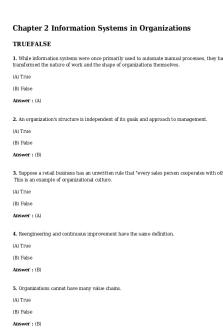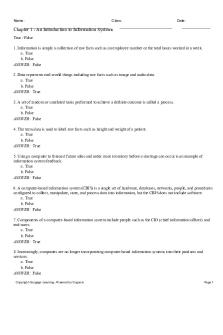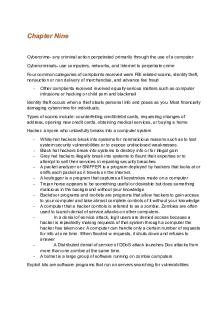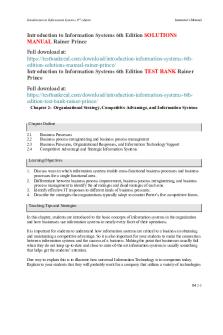IS readings ch2 part 2 - Introduction to Information Systems PDF

| Title | IS readings ch2 part 2 - Introduction to Information Systems |
|---|---|
| Course | Information Systems |
| Institution | McGill University |
| Pages | 4 |
| File Size | 201.9 KB |
| File Type | |
| Total Downloads | 47 |
| Total Views | 158 |
Summary
MGCR331 - IS readings ch2 part 2...
Description
IS READINGS CH2 PART 2 2.1 Business Processes ! → Business Processes
- A business process is an ongoing collection of related activities or tasks that in a specific
-
sequence create a product or a service of value to the organization, its business partners, and its customers. The process involves three fundamental elements:! - Inputs: Materials, services, and information that flow through and are transformed as a result of process activities! - Resources: People and equipment that perform process activities! - Outputs: The product or a service created by the process! 2 types of customers: internal (ex: a manager) or external (ex: a person that purchases an org’s products)!
- There are two fundamental metrics that organizations employ in assessing their processes: effectiveness and efficiency.! - Effectiveness is about getting things done! - Efficiency is about getting more things done with the same or fewer resources!
- Examples of Business Processes! - Accounting: Invoice management! - Finance: Credit approval process! - Marketing: Handling customer complaints! - Production/OM: Inventory mgt.! - Human Resources: Overseeing workplace safety! - Management Information System: Staff training! → Cross-functional processes
- No single functional area is responsible for their execution ! - For a cross-functional process to be successfully completed, each functional area must execute its specific process steps in a coordinated, collaborative way.!
- Multiple functional areas collaborate to perform the process.! - Ex: Order fulfillment process! - Theres two types of cross-functional processes: procurement and fulfillment ! - The procurement process includes all of the tasks involved in acquiring needed materials -
externally from a vendor. Procurement comprises five steps that are completed in three different functional areas of the firm: warehouse, purchasing, and accounting ! The fulfillment process is concerned with processing customer orders!
- An organization’s business processes can create a competitive advantage if they enable the company to innovate or to execute more effectively and efficiently than its competitors.!
→ Business process for ordering an online flight e-ticket !
→ Information Systems and Business Processes
- Information systems facilitate communication and coordination among different functional areas, and allow easy exchange of, and access to, data across processes. !
- Specifically, IS play a vital role in three areas:!
- executing the process: IS and the processes are usually intertwined. If the IS does not work, the process cannot be executed. “IS” is critical to execute a process. Process comes to life through IS. People can do their part if IS supports their interactions, provides info, reminds them, etc. It is the system that notifies me if the order is ready!!
- capturing and storing process data: Processes create data such as dates, times, product numbers, quantities, prices, and addresses, as well as who did what, when, and where. IS captures and stores these data, commonly referred to as process data or transaction data. A process is data rich. When a customer gets the order over the phone, she needs a system to store and processes that order!. IS lets you update information in one place and all other departments can access it (cross-functional IS)!
- monitoring process performance: A third contribution of IS is to help monitor the state of the various business processes. That is, the IS indicates how well a process is executing. The IS performs this role by evaluating information about a process. This information can be created at either the instance level (i.e., a specific task or activity) or at the process level (i.e., the process as a whole). Not only can the IS help monitor a process, but it can also detect problems with the process. The IS performs this role by comparing the information with a standard—that is, what the company expects or desires—to determine if the process is performing within expectations. We cannot monitor all transactions manually. System locates the parcel in shipment process. System generates notifications and acknowledgements as result of its analysis!
2.2 Business Process Reengineering, Business Process Improvement, and Business Process Management!
- Customer satisfaction: The result of optimizing and aligning business processes to fulfill customers’ needs, wants, and desires. !
- Cost reduction: The result of optimizing operations and supplier processes.! - Cycle and fulfilment time reduction: The result of optimizing the manufacturing and logistics processes.!
- Quality: The result of optimizing the design, development, and production processes.! - Differentiation: The result of optimizing the marketing and innovation processes.! - Productivity: The result of optimizing each individual work process.! → Business Process Reengineering
- business process reengineering (BPR), is a strategy for making an organization’s business processes more productive and profitable. !
- The key to BPR is for enterprises to examine their business processes from a “clean sheet” perspective and then determine how they can best reconstruct those processes to improve their business functions.! → Business Process Improvement
- BPI focuses on reducing variation in the process outputs (e.g., finished product) by searching
-
for root causes of the variation in the process itself (e.g., a broken machine on an assemble line) or among the process inputs (e.g., a decline in the quality of raw materials purchased from a certain supplier) ! Six Sigma is a popular methodology for BPI initiatives. Its goal is to ensure that the process has no more than 3.4 defects per million outputs by using statistical methods to analyze the process. ! A successful BPI project generally follows five basic phases: define, measure, analyze, improve, and control (DMAIC). ! Although BPI initiatives do not deliver the huge performance gains promised by BPR, many organizations prefer them because they are less risky and less costly. BPI focuses on delivering quantifiable results—and if a business case cannot be made, the project is not continued. !
→ Business Process Management
- To sustain BPI efforts over time, organizations can adopt business process management (BPM),
-
-
a management system that includes methods and tools to support the design, analysis, implementation, management, and continuous optimization of core business processes throughout the organization. BPM integrates disparate BPI initiatives to ensure consistent strategy execution. ! BPM begins with process modeling, which is a graphical depiction of all of the steps in a process. ! BPM initially helps companies improve profitability by decreasing costs and increasing revenues. Over time, BPM can create a competitive advantage by improving organizational flexibility—making it easy to adapt to changing business conditions and to take advantage of new opportunities! Business activity monitoring (BAM) is a real-time approach for measuring and managing business processes. Companies use BAM to monitor their business processes, identify failures
-
-
or exceptions, and address these failures in real time. Furthermore, because BAM tracks process operations and indicates whether they succeed or fail, it creates valuable records of process behaviors that organizations can use to improve their processes.! A BPMS is an integrated set of applications that includes a repository of process information such as process maps and business rules; tools for process modelling, simulation, execution, and coordination across functions; and reconfiguration in response to changing business needs as well as process-monitoring capabilities.! Social BPM enables employees to collaborate, using social media tools on wired and mobile platforms, both internally across functions and externally with stakeholders (such as customers or subject-area experts), to exchange process knowledge and improve process execution.!
→ BPI and Six Sigma
- six sigma is a popular methodology for BPI! - Its about quality control as improved quality control can reduce costs: ! - Increase productivity ! - lowers rework and scrap costs ! - Reduces warranty costs and time ! - Statistically based philosophy that aims to reduce defects, boost productivity, eliminate waste, and cut costs throughout a company.! - A Vision and Philosophical commitment to our consumers to offer the highest quality, lowest cost products! - A Metric that demonstrates quality levels at 99.9997% performance for products and processes! - A Benchmark of our product and process capability for comparison to ‘best in class’! - A practical application of statistical Tools and Methods to help us measure, analyze, improve, and control our process! → How to support BPI?
- Business Process Management - BPM! - A management system used to support continuous BPI initiatives for core business processes over time!
- Important components of BPM! - Process modeling Graphical depiction of all steps in out process! - Business activity monitoring (BAM)! - Where does failure lie?! ! → Tools for BPM -> BPM suits
- A set of integrated applications to accommodate changing business needs and create capacity for process-monitoring capabilities...
Similar Free PDFs

Introduction to Tox part 2
- 26 Pages

Introduction to Sensory Systems
- 4 Pages

Introduction to Digital Systems
- 222 Pages
Popular Institutions
- Tinajero National High School - Annex
- Politeknik Caltex Riau
- Yokohama City University
- SGT University
- University of Al-Qadisiyah
- Divine Word College of Vigan
- Techniek College Rotterdam
- Universidade de Santiago
- Universiti Teknologi MARA Cawangan Johor Kampus Pasir Gudang
- Poltekkes Kemenkes Yogyakarta
- Baguio City National High School
- Colegio san marcos
- preparatoria uno
- Centro de Bachillerato Tecnológico Industrial y de Servicios No. 107
- Dalian Maritime University
- Quang Trung Secondary School
- Colegio Tecnológico en Informática
- Corporación Regional de Educación Superior
- Grupo CEDVA
- Dar Al Uloom University
- Centro de Estudios Preuniversitarios de la Universidad Nacional de Ingeniería
- 上智大学
- Aakash International School, Nuna Majara
- San Felipe Neri Catholic School
- Kang Chiao International School - New Taipei City
- Misamis Occidental National High School
- Institución Educativa Escuela Normal Juan Ladrilleros
- Kolehiyo ng Pantukan
- Batanes State College
- Instituto Continental
- Sekolah Menengah Kejuruan Kesehatan Kaltara (Tarakan)
- Colegio de La Inmaculada Concepcion - Cebu



![OBrien - Introduction to Information Systems [2010]](https://pdfedu.com/img/crop/172x258/zx28ke2j06rw.jpg)








